Preface
The challenges facing instructors of calculus are daunting. Diversity among students, both in their mathematical preparedness for learning calculus and in their ultimate educational and career goals, is vast and growing. There is just not enough classroom time to teach every topic in the syllabus, to answer every student’s questions, or to delve into the rich examples and applications that showcase the beauty and utility of calculus. As mathematics instructors we share these frustrations with you. As authors our goal is to create a student-oriented textbook that supports your teaching philosophy and promotes student success and confidence.
Promoting Student Success Is the Central Theme
Our goal is to write a mathematically precise calculus book that embraces proven pedagogical features to increase both student and instructor success. Many of these features are structural, but there are also many less obvious, intrinsic features embedded in the text.
 The text is written to be read by students. The language is simple, clear, and consistent. Definitions are simply stated and consistently used. Theorems are given names where appropriate. Numbering of definitions, equations, and theorems is kept to a minimum.
The text is written to be read by students. The language is simple, clear, and consistent. Definitions are simply stated and consistently used. Theorems are given names where appropriate. Numbering of definitions, equations, and theorems is kept to a minimum.The careful use of color throughout the text brings attention to important statements such as definitions and theorems. Important formulas are boxed, and procedures and summaries are called out so that a student can quickly look back and review the main points of the section.
 The text is written to prepare students. Whether students have educational goals that end in the social sciences, in the life and/or physical sciences, in engineering, or with a PhD in mathematics, the text provides ample practice, applications, and the mathematical precision and rigor required to prepare students to pursue their goals.
The text is written to prepare students. Whether students have educational goals that end in the social sciences, in the life and/or physical sciences, in engineering, or with a PhD in mathematics, the text provides ample practice, applications, and the mathematical precision and rigor required to prepare students to pursue their goals. The text is written to be mastered by students. Carefully used pedagogical features are found throughout the text. These features provide structure and form a carefully crafted learning system that helps students get the most out of their study. From our experience, students who use the features are more successful in calculus.
The text is written to be mastered by students. Carefully used pedagogical features are found throughout the text. These features provide structure and form a carefully crafted learning system that helps students get the most out of their study. From our experience, students who use the features are more successful in calculus.
Pedagogical Features Promote Student Success
Just In Time Review Students forget; they often do not make connections. Instructors lament, “The students are not prepared!” So, throughout the text there are margin notes labeled NEED TO REVIEW? followed by a topic and page references. The NEED TO REVIEW? reference points to the discussion of a concept used in the current presentation.

RECALL margin notes provide a quick refresher of key results that are being used in theorems, definitions, and examples.

Additional margin notes are included throughout the text to help students understand and engage with the concepts. IN WORDS notes translate complex formulas, theorems, proofs, rules, and definitions using plain language that provide students with an alternate way to learn the concepts.

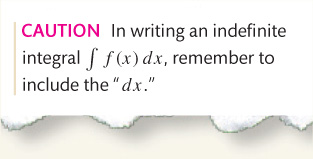
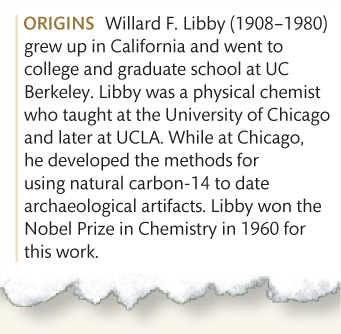
CAUTIONS and NOTES provide supporting details or warnings about common pitfalls. ORIGINS give biographical information or historical details about key figures and discoveries in the development of calculus.
Learning Objectives Students often need focus. Each section begins with a set of Objectives that serve as a broad outline of the section. The objectives help students study effectively by focusing attention on the concepts being covered. Each learning objective is supported by appropriate definitions, theorems, and proofs. One or more carefully chosen examples enhance the learning objective, and where appropriate, an application example is also included.
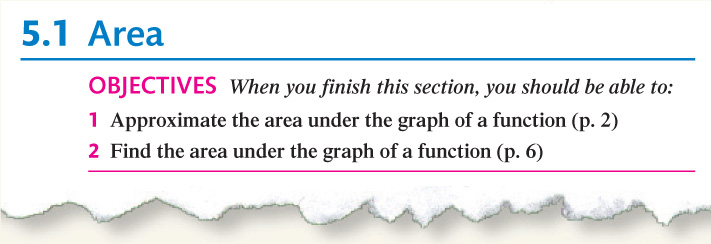
Learning objectives help instructors prepare a syllabus that includes the important topics of calculus, and concentrate instruction on mastery of these topics. They are also helpful for answering the familiar question, “What is on the test?”
Effective Use of Color The text contains an abundance of graphs and illustrations that carefully utilize color to make concepts easier to visualize.
Dynamic Figures The text includes many pieces of art that students, can interact with through the online e-Book. These dynamic figures, indicated by the icon ![]() next to the figure label, illustrate select principles of calculus including limits, rates of change, solids of revolution, convergence, and divergence.
next to the figure label, illustrate select principles of calculus including limits, rates of change, solids of revolution, convergence, and divergence.

Examples with Detailed and Annotated Solutions: Examples are named according to their purpose. The text includes hundreds of examples with detailed step-by-step solutions. Additional annotations provide students with the formula used, or the reasoning needed, to perform a particular step of the solution. Where procedural steps for solving a type of problem are given in the text, these steps are followed in the solved examples. Often a figure or a graph is included to complement the solution.
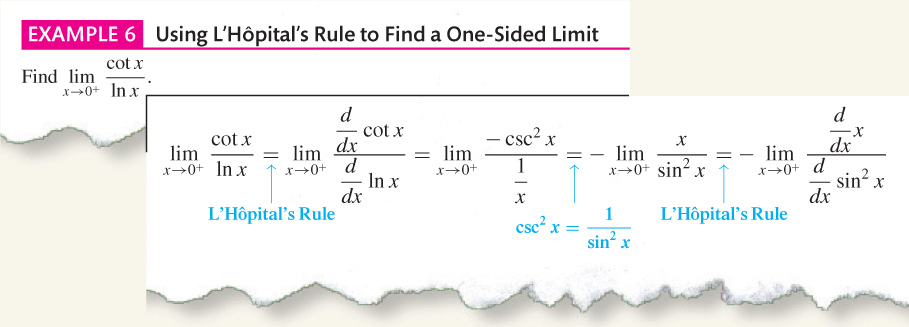
Application Examples and Chapter Projects The inclusion of application examples motivates and underscores the conceptual theory, and powerfully conveys the message that calculus is a beneficial and a relevant subject to master. It is this combination of concepts with applied examples and exercises that gives students the tools not only to complete the exercises successfully, but also to comprehend the mathematics behind them.
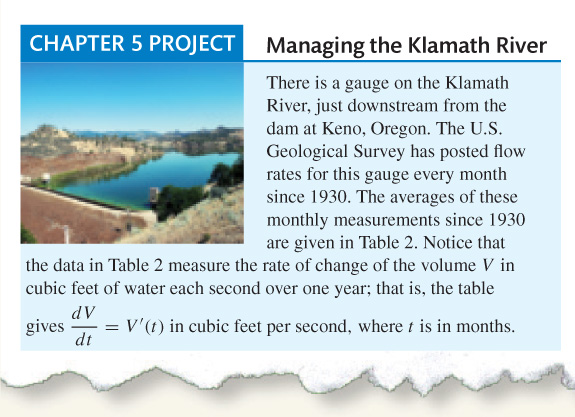
This message is further reinforced by the case studies that open each chapter, demonstrating how major concepts apply to recognizable and often contemporary situations in biology, environmental studies, astronomy, engineering, technology, and other fields. Students see this case study again at the end of the chapter, where an extended project presents questions that guide students through a solution to the situation.
Immediate Reinforcement of Skills Following most examples there is the statement, ![]() . This callout directs students to a related exercise from the section’s problem set. Math is best learned actively. Doing a related problem immediately after working through a solved example not only keeps students engaged, but also enhances understanding and strengthens their ability to apply the objective. This practice also serves as a confidence-builder for students.
. This callout directs students to a related exercise from the section’s problem set. Math is best learned actively. Doing a related problem immediately after working through a solved example not only keeps students engaged, but also enhances understanding and strengthens their ability to apply the objective. This practice also serves as a confidence-builder for students.
The Text Is Written with Ample Opportunity to Practice
Check Comprehension Before the Test Immediately after reading a section, we suggest that students assess their comprehension of the main points of the section by answering the Concepts and Vocabulary questions. These are a selection of quick fill in the blank, multiple-choice, and true/false questions. If a student has trouble answering these questions correctly, then a flag is raised immediately—go back and review the section or get help from the instructor.
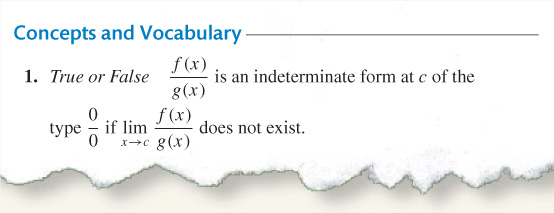
Instructors may find Concept and Vocabulary problems useful for a class-opening, for a 5-minute quiz, or for iClicker responses to determine if students are prepared for class.
Practice, the Best Way to Learn Calculus The Skill Building exercises are grouped into subsets, usually corresponding to the objectives of the section, and are correlated to the solved examples. Working a variety of Skill Building problems increases students’ computational skills and ability to choose the best approach to solve a problem. The result: Student success, which builds student confidence.
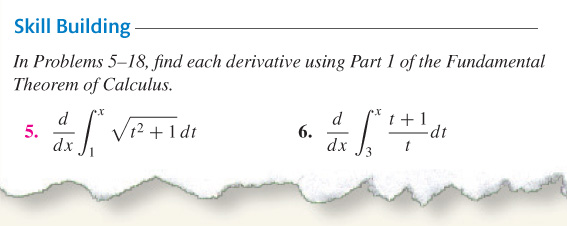
Having mastered the computational skills, students are ready to tackle the Application and Extension problems. These are a diverse set of applied problems, some of which have been contributed by calculus students from various colleges and universities. The Application and Extension section also includes problems that use a slightly different approach to the section material, problems that require proof, and problems that extend the concepts of the section.
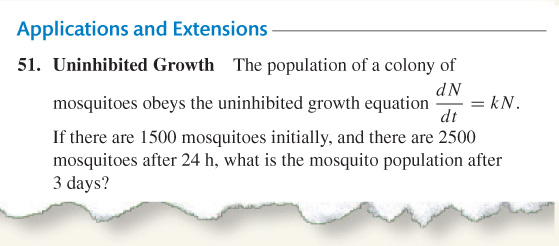
For students requiring more of a challenge, the Challenge Problems provide more difficult extensions of the section material. Often combined with concepts learned in previous chapters, Challenge Problems are intended to be thought-provoking problems that require some ingenuity to solve. They are designed to challenge the stronger students in the class.

Review, the Way to Reach Higher Levels of Learning Student success can be measured in many ways. Often in school student success is measured by a test. Recognizing this, each chapter, other than Chapter P, concludes with a Chapter Review. The review incorporates pedagogical features found in few advanced mathematics texts. Each Chapter Review consists of
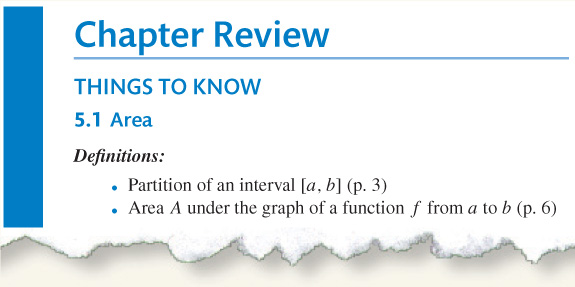
 Things to Know, a detailed list of important definitions, formulas, and theorems contained in the chapter and page references to where they can be found.
Things to Know, a detailed list of important definitions, formulas, and theorems contained in the chapter and page references to where they can be found. Objectives Table, which follows Things to Know. This table provides a section-by-section list of the learning objectives of the chapter (with page references), along with references to the worked examples and the review problems pertaining to the particular learning objective.
Objectives Table, which follows Things to Know. This table provides a section-by-section list of the learning objectives of the chapter (with page references), along with references to the worked examples and the review problems pertaining to the particular learning objective.
 Review Problems that provide a comprehensive review of the key concepts of the chapter, matched to the learning objectives of each section.
Review Problems that provide a comprehensive review of the key concepts of the chapter, matched to the learning objectives of each section.
By using the review exercises to study, a student can identify the objectives mastered and those that need additional work. By referring back to the objective(s) of problems missed, reviewing the material for that objective, reworking the ![]() Problem(s), and trying the review problem again, a student should have the skills and the confidence to take an exam or proceed to the next chapter.
Problem(s), and trying the review problem again, a student should have the skills and the confidence to take an exam or proceed to the next chapter.
Student success is ultimately measured by deep understanding and the ability to extend knowledge. When reviewing and incorporating previous knowledge, students begin to make connections. Once connections are formed, understanding and mastery follow.
In addition to these explicit pedagogical features, there are less obvious, but certainly no less significant, features that have been woven into the text. As educators and as students we realize that learning new material is often made more difficult when the style of presentation changes, so we have striven to keep the language and notation consistent throughout the book. Definitions are used in their entirety, both when presented and later when applied. This consistency is followed throughout the text and the exercises. Such attention to the consistency of language and notation is mirrored in our approach to writing precise mathematics while keeping the language clear and accessible to students.
The pedagogical features are tools that will aid students in their mastery of calculus. But it is the clarity of writing that allows students to master the understanding and to use the tools effectively. The accuracy of the mathematics and transparency in the writing will guarantee that any dedicated student can come to grips with the underlying theories, without having to decipher confusing dialogue.
It is our hope that you can encourage your students to read the textbook, use its features, practice the problems, and get help as soon as they need it. Our desire is that we, as a team, can build a cadre of confident and successful calculus students ready to pursue their dreams and goals!
Organizational Features That Set This Text Apart
Appendix A is a brief review of topics that students might have forgotten, but are used throughout calculus. The content of Appendix A consists of material studied prior to the introduction of functions in precalculus. Although definitions, theorems, and examples are provided in Appendix A, this appendix includes no exercises. The purpose of Appendix A is to refresh the student’s memory of previously mastered concepts from prerequisite courses. You may wish to look at the content found in Appendix A. In particular, notice that summation notation, used in Chapter 5, is discussed in Section A.5
Chapter P deals with functions encountered in precalculus. It is designed either to be a quickly covered refresher at the beginning of the course or to be a just-in-time review used when needed. As such, the sections of Chapter P are lean and include only a limited number of practice problems that reinforce the reviewed topics.
Chapter 1 is dedicated to limits and continuity. Although most of the chapter addresses the idea of a limit and methods of finding limits, we state the formal ɛ-δ definition of limit in Section 1. We also include an example that investigates how close x must be to c to ensure that the difference between f(x) and L is less than some prescribed number. But it is not until Section 6, after students are comfortable with the concept of a limit, the procedures of finding limits, and properties of limits, that the ɛ-δ definition of limit is repeated, discussed, and applied.
The Derivative has been split into two chapters (Chapters 2 and 3). This allows us to expand the coverage of the derivative and avoid a chapter of unwieldy length. Chapter 2 includes rates of change, the derivative as a function, and the Sum, Difference, Product, Quotient, and Simple Power rules for finding derivatives. It also contains derivatives of the exponential function and the trigonometric functions.
Chapter 3 covers the Chain Rule, implicit differentiation, the derivative of logarithmic and hyperbolic functions, differentials and linear approximations, and the approximation of zeros of functions using Newton’s method.
Notice that there is also a section on Taylor polynomials (Section 3.5). We feel that the logical place for Taylor polynomials is immediately after differentials and linear approximations. It is natural to ask, “If a linear approximation to a function f near x = x0 is good in a small interval surrounding x0, then does a higher degree polynomial provide a better approximation of a function f over a wider interval?”
We begin Chapter 6, by finding the volume of a solid of revolution using the disk and washer method, followed by the shell method. We use both methods to solve several examples. This parallel approach enhances the student’s appreciation of which method to choose when asked to find a volume. Only then do we introduce the slicing method, which is a generalization of the disk and washer method.
In Chapter 8, students are asked to recall the Taylor Polynomials studied earlier. The early exposure to the Taylor Polynomials serves two purposes here: First, it distinguishes a Taylor Polynomial from a Taylor Series; and second, it helps to make the idea of convergence of a Taylor Series easier to understand.
In addition to Chapter 16, Differential Equations, we provide examples of differential equations throughout the text. They are first introduced in Chapter 4: Applications of the Derivative, along with antiderivatives (Section 4.8). Again, the placement is a logical consequence of the relationship between derivatives and antiderivatives. At this point the idea of boundary values is introduced. Differential equations are revisited a second time in Chapter 5, The Integral, with the discussion of exponential growth (Section 5.5) and Newton’s Law of Cooling (Section 5.6).